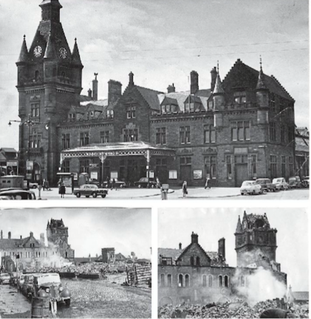Dundee West railway station | |||||
|---|---|---|---|---|---|
 Dundee West railway station on 1 May 1965 (top); during its demolition the following year (bottom) | |||||
| General information | |||||
| Location | Dundee, Dundee Scotland | ||||
| Coordinates | 56°27′29″N2°58′11″W / 56.4581°N 2.9698°W | ||||
| Grid reference | NO403299 | ||||
| Platforms | 2 | ||||
| Other information | |||||
| Status | Disused | ||||
| History | |||||
| Original company | Dundee and Perth Railway | ||||
| Pre-grouping | Caledonian Railway | ||||
| Post-grouping | London, Midland and Scottish Railway | ||||
| Key dates | |||||
| 24 May 1847 | Opened as Dundee | ||||
| 1848 | Name changed to Dundee West | ||||
| 1853 | Name changed to Dundee West Street | ||||
| 1856 | Name changed to Dundee Union Street | ||||
| 1866 | Name changed back to Dundee West | ||||
| 1 May 1965 | Closed | ||||
| |||||
Dundee West railway station served the city of Dundee, Scotland, from 1847 to 1965 on the Dundee and Perth Railway. Author John Minnis has described demolition of the "wonderful" station building (built between 1889 and 1890) as "perhaps the most tragic loss" of a piece of railway architecture in Scotland. [1]
